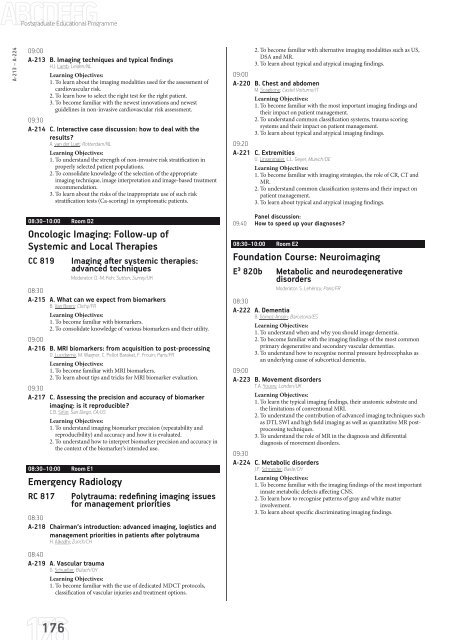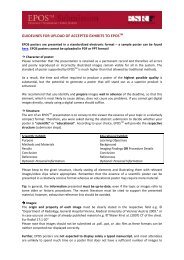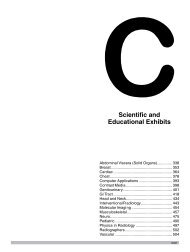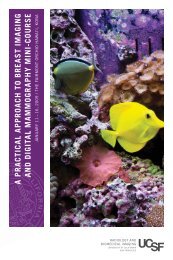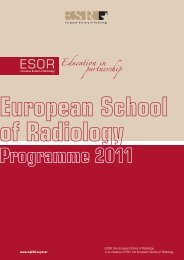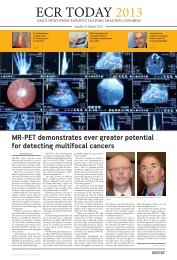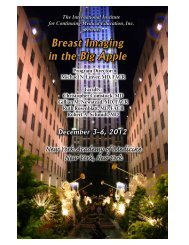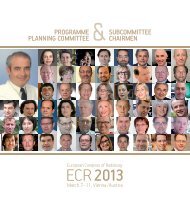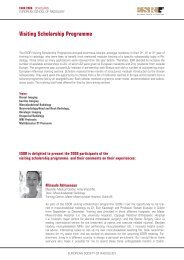ECR 2013 â Final Programme - myESR.org
ECR 2013 â Final Programme - myESR.org
ECR 2013 â Final Programme - myESR.org
- No tags were found...
Create successful ePaper yourself
Turn your PDF publications into a flip-book with our unique Google optimized e-Paper software.
Postgraduate Educational <strong>Programme</strong>A-213 – A-22409:00A-213 B. Imaging techniques and typical findingsH.J. Lamb; Leiden/NLLearning Objectives:1. To learn about the imaging modalities used for the assessment ofcardiovascular risk.2. To learn how to select the right test for the right patient.3. To become familiar with the newest innovations and newestguidelines in non-invasive cardiovascular risk assessment.09:30A-214 C. Interactive case discussion: how to deal with theresults?A. van der Lugt; Rotterdam/NLLearning Objectives:1. To understand the strength of non-invasive risk stratification inproperly selected patient populations.2. To consolidate knowledge of the selection of the appropriateimaging technique, image interpretation and image-based treatmentrecommendation.3. To learn about the risks of the inappropriate use of such riskstratification tests (Ca-scoring) in symptomatic patients.2. To become familiar with alternative imaging modalities such as US,DSA and MR.3. To learn about typical and atypical imaging findings.09:00A-220 B. Chest and abdomenM. Scaglione; Castel Volturno/ITLearning Objectives:1. To become familiar with the most important imaging findings andtheir impact on patient management.2. To understand common classification systems, trauma scoringsystems and their impact on patient management.3. To learn about typical and atypical imaging findings.09:20A-221 C. ExtremitiesU. Linsenmaier, L.L. Geyer; Munich/DELearning Objectives:1. To become familiar with imaging strategies, the role of CR, CT andMR.2. To understand common classification systems and their impact onpatient management.3. To learn about typical and atypical imaging findings.08:30–10:00 Room D2Oncologic Imaging: Follow-up ofSystemic and Local TherapiesCC 819 Imaging after systemic therapies:advanced techniquesModerator: D.-M. Koh; Sutton, Surrey/UK08:30A-215 A. What can we expect from biomarkersB. Van Beers; Clichy/FRLearning Objectives:1. To become familiar with biomarkers.2. To consolidate knowledge of various biomarkers and their utility.09:00A-216 B. MRI biomarkers: from acquisition to post-processingO. Lucidarme, M. Wagner, C. Pellot Barakat, F. Frouin; Paris/FRLearning Objectives:1. To become familiar with MRI biomarkers.2. To learn about tips and tricks for MRI biomarker evaluation.09:30A-217 C. Assessing the precision and accuracy of biomarkerimaging: is it reproducible?C.B. Sirlin; San Diego, CA/USLearning Objectives:1. To understand imaging biomarker precision (repeatability andreproducibility) and accuracy and how it is evaluated.2. To understand how to interpret biomarker precision and accuracy inthe context of the biomarker‘s intended use.08:30–10:00 Room E1Emergency RadiologyRC 817 Polytrauma: redefining imaging issuesfor management priorities08:30A-218 Chairman‘s introduction: advanced imaging, logistics andmanagement priorities in patients after polytraumaH. Alkadhi; Zurich/CH08:40A-219 A. Vascular traumaG. Schueller; Bülach/CHLearning Objectives:1. To become familiar with the use of dedicated MDCT protocols,classification of vascular injuries and treatment options.Panel discussion:09:40 How to speed up your diagnoses?08:30–10:00 Room E2Foundation Course: NeuroimagingE³ 820b Metabolic and neurodegenerativedisordersModerator: S. Lehéricy; Paris/FR08:30A-222 A. DementiaB. Gómez-Ansón; Barcelona/ESLearning Objectives:1. To understand when and why you should image dementia.2. To become familiar with the imaging findings of the most commonprimary degenerative and secondary vascular dementias.3. To understand how to recognise normal pressure hydrocephalus asan underlying cause of subcortical dementia.09:00A-223 B. Movement disordersT.A. Yousry; London/UKLearning Objectives:1. To learn the typical imaging findings, their anatomic substrate andthe limitations of conventional MRI.2. To understand the contribution of advanced imaging techniques suchas DTI, SWI and high field imaging as well as quantitative MR postprocessingtechniques.3. To understand the role of MR in the diagnosis and differentialdiagnosis of movement disorders.09:30A-224 C. Metabolic disordersJ.F. Schneider; Basle/CHLearning Objectives:1. To become familiar with the imaging findings of the most importantinnate metabolic defects affecting CNS.2. To learn how to recognise patterns of gray and white matterinvolvement.3. To learn about specific discriminating imaging findings.176


